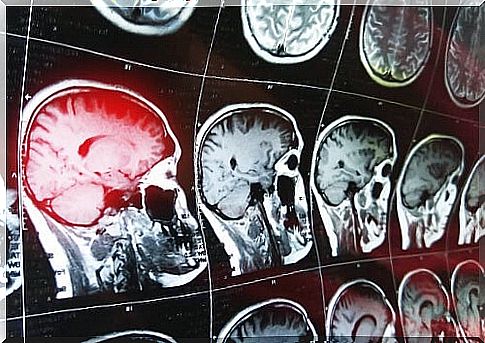Confabulations – What Are They And Why Do They Appear?

As part of the cognitive processes that humans have, memory is one of the best researched. However, it is still a complex topic that also covers the issue that we will discuss in this article. In order to understand what confabulations are , it is important to know that they come from the distortion of certain memories.
Memories in memory are not exact reconstructions of events. Everyone can remember an event differently and assure that it has happened. It is normal to experience some distortion of reality due to information loss. On the other hand, confabulations are supposed memories.
A clear example of this type of memory is found in elderly people with severe neurocognitive impairment (senile dementia). They can assure that they experienced something completely different from the actual events.
Confabulations – their types and classification
Confabulation is a cognitive phenomenon that is quite difficult to characterize, given that it can take many forms. However, there are 5 criteria for classifying these cognitive changes. Let’s take a closer look at them.
1. Spontaneous confabulations
This first type of confabulation is the shortest. These are fancy ideas that a person presents emphatically as real events. They usually occur in patients with Korsakoff’s syndrome.
2. Provoked confabulations
In this case, what happens is that the memory does not recall something precisely. This type is common in patients with amnesia. Something similar happens when a healthy person tries to preserve certain information forcibly over a long period of time.
For example, reading literally for an exam can cause memory problems. At the time of passing the exam, certain concepts may change and insistence as to their truthfulness, even if they do not correspond to reality.

3. Simple provoked distortions
These distortions occur when a person is forced to recall information in detail. Imagine for a moment that we forget about the shopping list and try to remember what it contained. Unknowingly, we might have bought something that was not on the list, but that we recovered from our memory.
4. Momentary confabulations
This type of memory failure is the most common type of confabulation. These are not very fantastic stories that can be completely plausible.
However, they are easy to spot. For example, when a patient details his plans in detail, but it is obvious that they are not achievable. In nursing homes, it is not uncommon for some older people to say that they will visit their childhood or adolescent friends, even if they have already died.
5. Fantastic confabulations
This type of confabulation is the most intense because of the great detachment from reality of the stories they present. As the name suggests, these are fantastic stories that are only credible for the patient. These reality disorders are common in patients with psychotic and paralytic dementia.
A different classification
The above classification of the 5 types of confabulations we have seen was proposed by Kopelman and most accurately determines the intensity and frequency of confabulated stories. Another division used for years was proposed by Schnider. This classification, in turn, takes into account 4 criteria of confabulation:
- Content: It is determined how credible the story can be, making use of thresholds that go from true to false.
- The mode in which they appear : spontaneous or provoked.
- Fields in which it manifests itself: episodic, autobiographical, general semantic or personal semantic.
- Clinical syndrome in which they occur.
What symptoms are associated with confabulation?
The symptoms of confabulation also differ from one another depending on the disorder causing them. For example, in Alzheimer’s disease, the most characteristic symptoms are cognitive deficits, mental weakness, and memory problems.
Let’s see what other symptoms may appear depending on the neurological disorder:
- Dementia: Memory impairment accompanied by nervousness.
- Schizophrenia: thought disturbances, acoustic hallucinations, paranoia.
- Korsakoff Syndrome: Recent Memory Loss, Mania, and Repetitive Behavior.
- Asomatognosia: inability to integrate body parts or recognize them, false sensations associated with the loss of a member.
Possible causes of confabulation
The causes of confabulation-inducing memory disorders in patients are related to damage to the frontal part of the brain. In particular, the affected area is the anterior basal surface, where the orbitofrontal and ventromedial areas are located.
There are three theories that try to explain the causes of confabulation. We present them briefly below. It is important to know that the hypotheses arose from a neuropsychological perspective.
1. Memory dysfunction
This theory states that confabulations are a form of amnesia. The main postulate is that memory disorders resemble the way of making sense of incomplete memories that can be retrieved by patients. This hypothesis is generally well received.
2. Executive dysfunction
On the other hand, the executive dysfunction theory says that when there are serious limitations in mental planning and determining the specific objectives, there are failures of memory, which leads to confabulation.
3. Double hypothesis
In this hypothesis, none of the previous postulates is excluded and it is maintained that confabulations result from a deficit of executive processes (higher functions of consciousness) as well as from memory disorders.
How can this phenomenon be treated?

The generally accepted view that confabulations are incurable consequences. However, there is a therapeutic approach that can improve the quality of life of patients who confabulate after suffering a brain injury. It is a neuropsychological procedure that relies on confrontation as a means of cognitive stimulation.
This treatment was designed by scientists from the University of Granada. It consists in showing patients a series of images in sequence, which, however, may differ in content. Then patients are asked to recall what they have seen.
At the moment of the reminder, confabulations take place and at these moments the specialists conducting the research question.
So it is shown to patients that the memory they present as real is not actually so. Then the pictures are shown to them again. At the same time, it is made clear that their memory is making mistakes. In neuropsychology, this process is called feedback.
You can expect an improvement after just 9 sessions.
What if I know someone who is confabulating?
If you come across a person who may be presenting some kind of confabulation, the best thing you can do is not to insist vehemently that he is wrong. Remember that for such a person it is a real event. We must be empathetic and avoid generating stress.
Then, it is worth consulting a specialist who can assess and determine the intensity of memory loss in order to determine further actions. Some patients stop confabulating after a while and do not require hospitalization.









